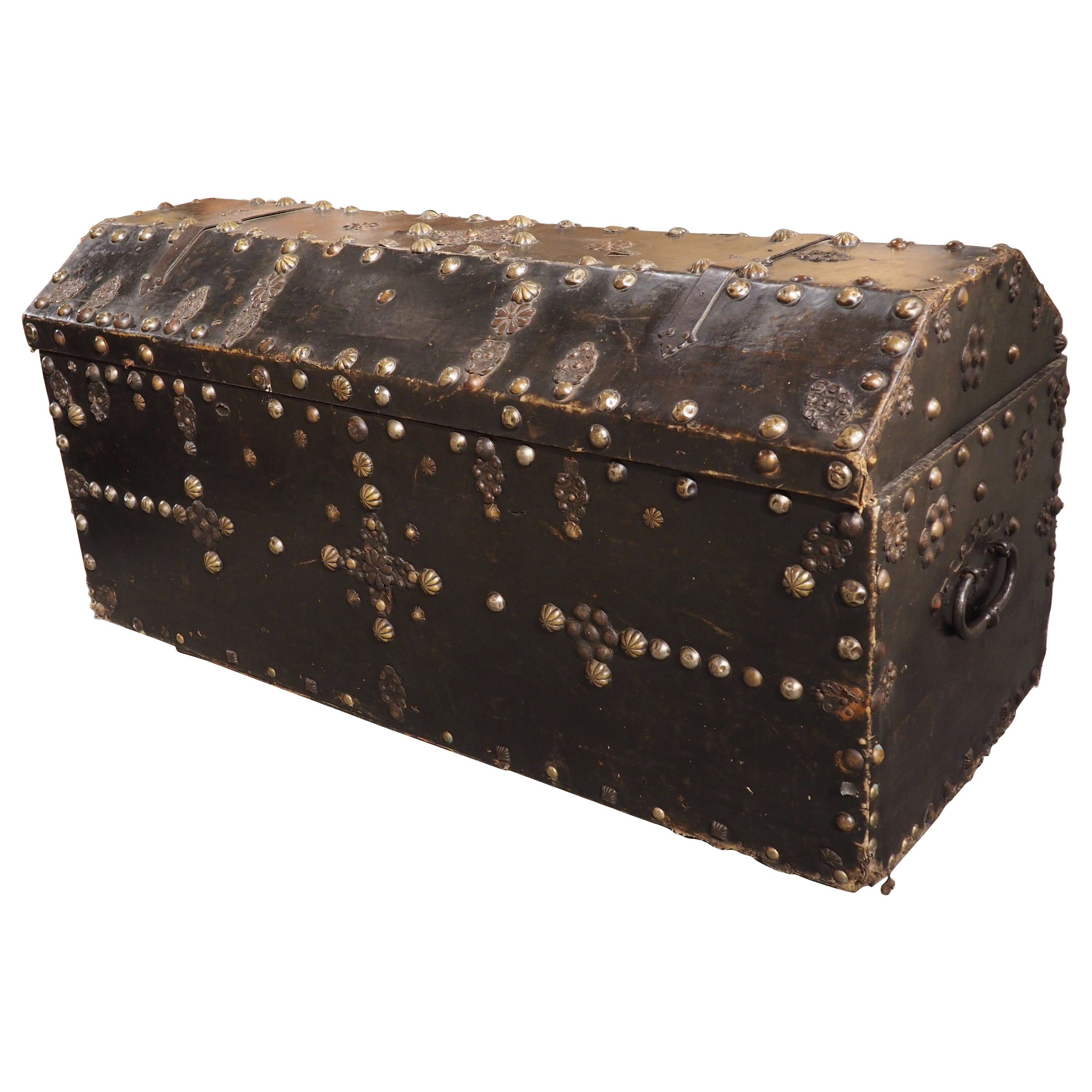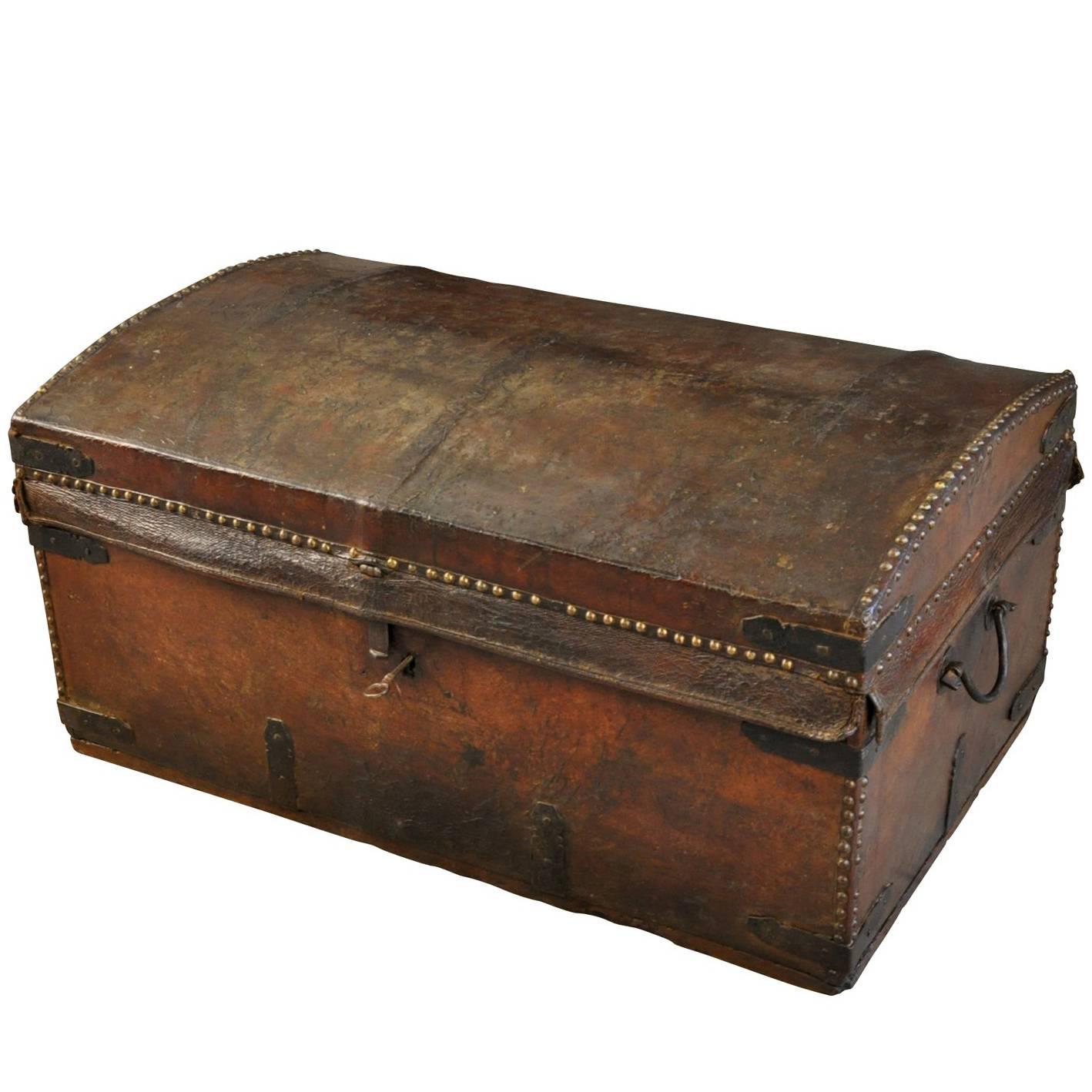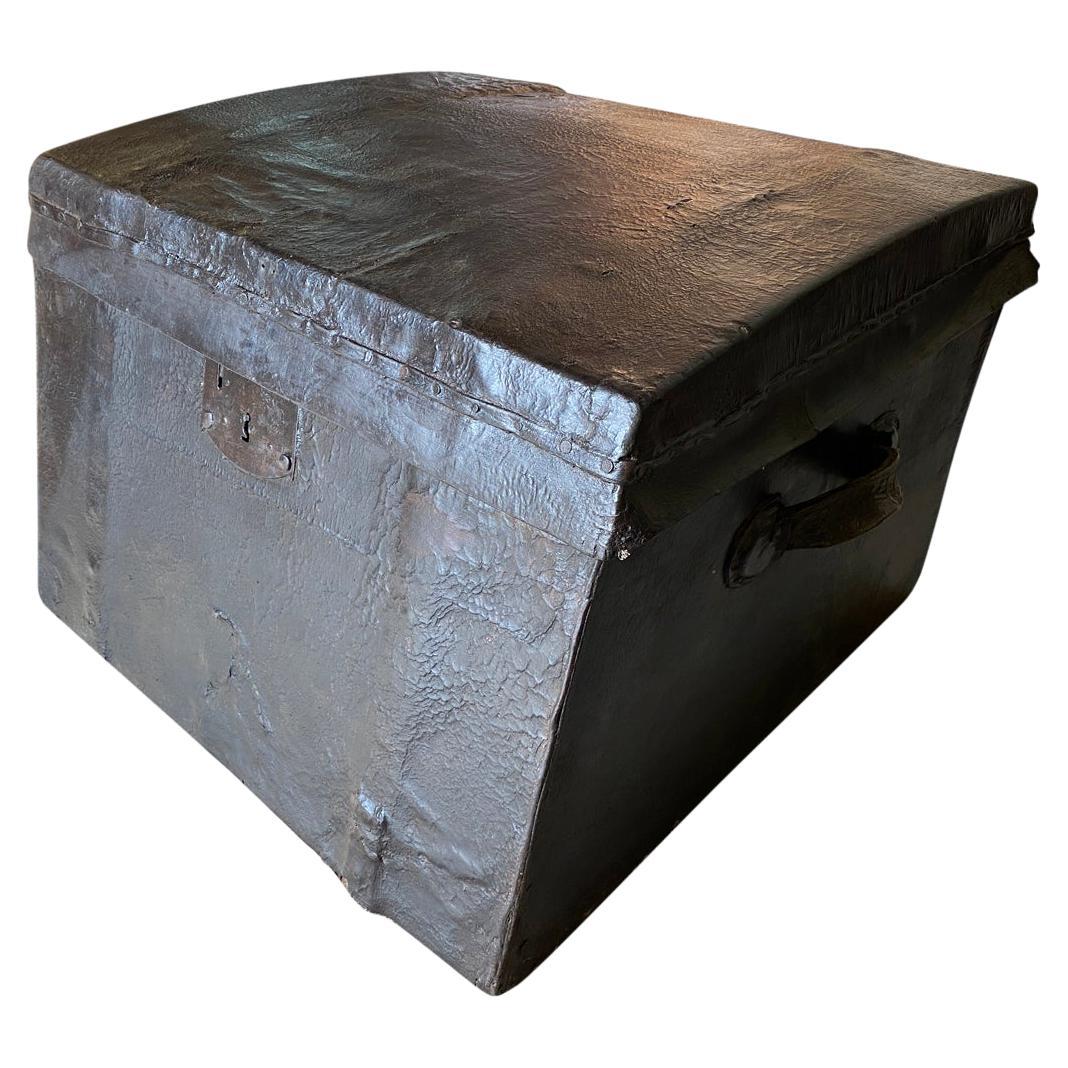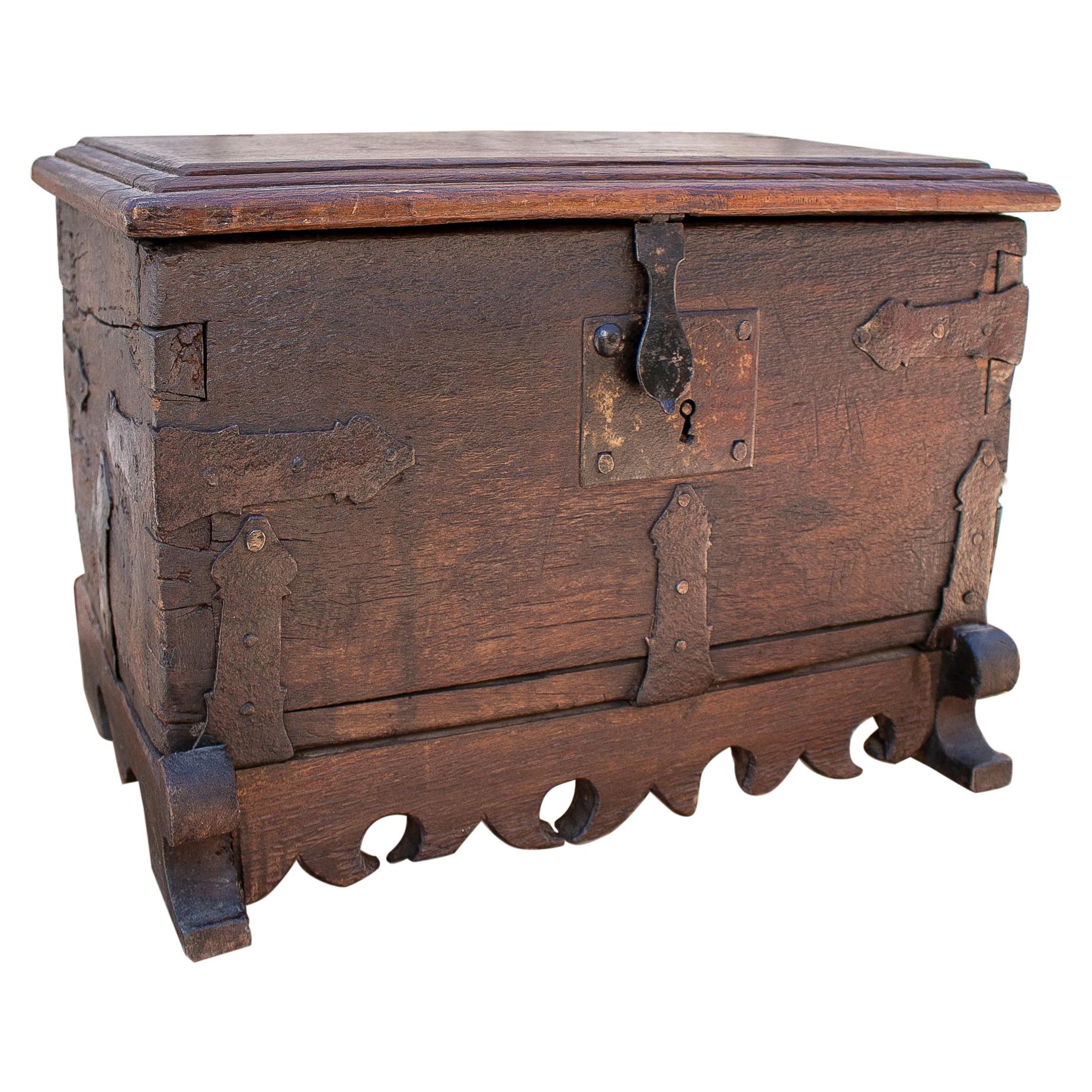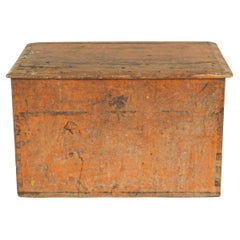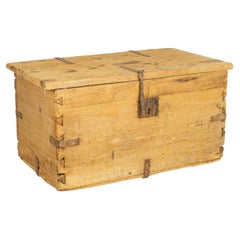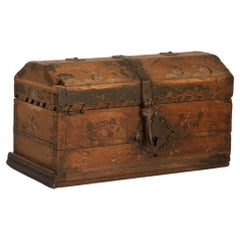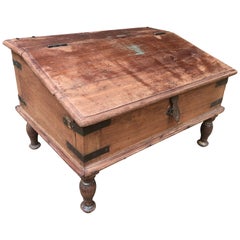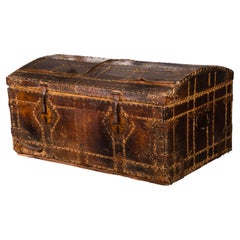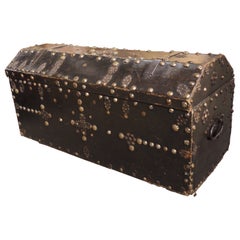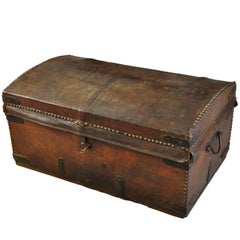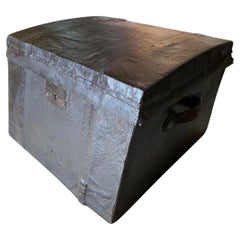Items Similar to Mid 18th Century Leather Upholstered Arcon found in Jalisco Western Mexico
Want more images or videos?
Request additional images or videos from the seller
1 of 12
Mid 18th Century Leather Upholstered Arcon found in Jalisco Western Mexico
$2,700
£2,064.29
€2,377.65
CA$3,783.53
A$4,223.95
CHF 2,213.29
MX$51,705.33
NOK 28,108.78
SEK 26,503.01
DKK 17,744.64
Shipping
Retrieving quote...The 1stDibs Promise:
Authenticity Guarantee,
Money-Back Guarantee,
24-Hour Cancellation
About the Item
Mid 18th Century Leather Upholstered Arcon found in Jalisco Western Mexico
This Arcon is in exceptional condition, the exterior is upholstered in brown/green leather. The wrought iron hasp, escutcheon, lock, ring hinges and side carrying handles are original. Wear, losses and repairs to leather commensurate with age.
Origin: Teocaltiche, Jalisco / Western México
Date of manufacture: Mid 18th Century
Materials: Hand-crafted mesquite wood / Leather / Forged iron.
- Dimensions:Height: 14.97 in (38 cm)Width: 32.68 in (83 cm)Depth: 17.33 in (44 cm)
- Style:Spanish Colonial (Of the Period)
- Materials and Techniques:
- Place of Origin:
- Period:
- Date of Manufacture:1760
- Condition:Wear consistent with age and use. Minor losses. Minor structural damages. Minor fading.
- Seller Location:Guadalajra, MX
- Reference Number:Seller: BA-005121stDibs: LU3550320025992
About the Seller
4.5
Vetted Professional Seller
Every seller passes strict standards for authenticity and reliability
1stDibs seller since 2018
24 sales on 1stDibs
- ShippingRetrieving quote...Shipping from: Guadalajara, Mexico
- Return Policy
Authenticity Guarantee
In the unlikely event there’s an issue with an item’s authenticity, contact us within 1 year for a full refund. DetailsMoney-Back Guarantee
If your item is not as described, is damaged in transit, or does not arrive, contact us within 7 days for a full refund. Details24-Hour Cancellation
You have a 24-hour grace period in which to reconsider your purchase, with no questions asked.Vetted Professional Sellers
Our world-class sellers must adhere to strict standards for service and quality, maintaining the integrity of our listings.Price-Match Guarantee
If you find that a seller listed the same item for a lower price elsewhere, we’ll match it.Trusted Global Delivery
Our best-in-class carrier network provides specialized shipping options worldwide, including custom delivery.More From This Seller
View AllMid 19th Century Spanish Mesquite Trunk Found in Zacatecas / Western México
By G. None
Located in Guadalajra, Jal
Beautiful mezquite wood trunk with remains of orange paint, found in Zacatecas, Western Mexico.
The piece in general shows wear but we find that it only adds character to this 250 year old trunk.
It will be a great piece with functional storage, perfect for storing blankets in a guest bedroom...
Category
Antique Mid-19th Century Mexican Spanish Colonial Trunks and Luggage
Materials
Wood
Mid 18th Century Hand-Carved Sabino Wood Trunk found in Jalisco / Western México
By G. None
Located in Guadalajra, Jal
This Mexican Colonial trunk is hand crafted with Sabino wood, it features hand iron forged handles and hinges and has an amazing dovetailed joints.
The piece in general shows wear b...
Category
Antique Mid-18th Century Mexican Spanish Colonial Blanket Chests
Materials
Wood
Small Antique Spanish Colonial Chest, Late 1700’s
By NONO
Located in Guadalajra, Jal
Small Antique Spanish Colonial Chest, Late 1700’s
Small colonial chest made of mesquite wood with remnants of paint. Assembled with dovetail joints and featuring impressive wrought i...
Category
Antique Late 18th Century Mexican Spanish Colonial Antiquities
Materials
Wood
English Hard Wood Portable Writing Desk, circa 1850
By OTHR
Located in Guadalajra, Jal
English country portable writing desk with lifting writing surface, it has its original bronze ironworks, late 18th century.
Category
Antique Late 18th Century Mexican Rustic Desks and Writing Tables
Materials
Hardwood
19th Century Hand-Carved Chair Found in Wester México
Located in Guadalajra, Jal
Detailed hand-carved and colorful chair found in Western México, circa 1900.
Category
Early 20th Century Folk Art Chairs
Materials
Wood
Mid 18th Century Glazed Ceramic Botija found in Southern Mexico
By G. None
Located in Guadalajra, Jal
This elegant antique jar was hand-crafted in Spain circa 1760; round in shape with narrow base and neck, the vessel features a rolled rim at the top accented with a mustard color gla...
Category
Antique Mid-18th Century Mexican Spanish Colonial Ceramics
Materials
Ceramic, Terracotta
You May Also Like
Trunk. Wood, leather, iron. Spanish school, around 1700.
Located in Madrid, ES
Trunk. Wood, leather, iron. Spanish school, around 1700.
Wooden trunk with curved lid and rectangular shape, covered in leather on the outside, with hardware, handles, studs and two...
Category
Antique 18th Century Spanish Neoclassical Trunks and Luggage
Materials
Other
18th Century Spanish Leather Trunk with Large Studded Nailhead Decoration
Located in Dallas, TX
A fantastic Spanish trunk with an angular dome top, the wood has been covered in leather on all sides except the back. The deep chocolate color leather has been affixed with various ...
Category
Antique 18th Century Spanish Trunks and Luggage
Materials
Iron
Mid-19th Century Italian Trunk
Located in Round Top, TX
A very handsome mid-19th century trunk, malle from Northern Italy. Wonderfully constructed from leather with iron bindings. Terrific patina.
Category
Antique Mid-19th Century Italian Trunks and Luggage
Materials
Leather
French 18th Century Leather Trunk
Located in Round Top, TX
A wonderful mid-18th century leather clad trunk - coffee from the South of France. Fabulous patina.
Category
Antique 18th Century French Trunks and Luggage
Materials
Leather
18th Century Spanish Wooden Trunk with Iron Hardware
Located in Marbella, ES
Antique 18th century Spanish wooden trunk with iron hardware.
Category
Antique 18th Century Spanish Trunks and Luggage
Materials
Wood
Boiled Leather Trunk, Spanish, 17th Century
Located in Bruxelles, BE
Leather trunk
Spanish, 17th century
Boiled Leather, wood and iron
Measures: 22 x 53 x 32 cm.
Provenance :
- collection Metz-Noblat, Château de Clevant, France
Rectangular trunk of the form and size of a small suitcase with wrought iron hinges and lock-plate.
Wood, covered with leather, cut and embossed with every surface of the thick cow hide covered in interlace, zoomorphic features.
The construction method is boiled leather, often referred to by its French translation cuir-bouilli: a process used to change flexible, vegetable-tanned leather into rigid, moulded objects. For shaping of the vegetable-tanned leather, heat and moisture were used, as indicated by the term boiled leather. No written medieval sources describing the production of decorated cuir bouilli objects survive, so knowledge of the process relies on the important studies of the Scottish leather historian John William Waterer. A large range of methods, materials and techniques could be used in various combinations. The vegetable-tanned leather, made supple with moisture and heat, was stuffed, shaped and nailed to the rigid wooden coffer support. The stuffing material was probably modeled beeswax or stearin wax. To shape the leather, to create its topography, « Cushions » were made by lacing a thread through an awl hole and attaching the flexible leather and stuffing to the rigid wooden support on the bottom. Then the decoration was done: lines were incised through the upper layer of the leather (epidermis) with different thicknesses of knives or needles. Contours were created with deep v-shaped cuts, decoration with thin incision and final details with a needle point. For the incision and pouncing stage, the leather was probably kept heated and moistened for suppleness.
Once dry, the leather would be hard and rigid.
the saturated leather is worked over a form, possibly even damp sand, with the pattern shaped using bone or wooden tools. Compare to metal, leather was lighter and it offered protection from cuts and punctures. Cuir bouilli objects were produced by specialist leather workers and needed skillful craftsmanship.
The surface is filled with roundels shaped foliages enclosing animals, lions and peacocks. The foliate arabesques creating a vegetal connection tweet the animals create the impression of a lush verdant space . The vegetal pattern here employed in combination with geometrical pattern came from the pre-islamic artistic traditions of the Byzantine and Sasanian empires. An aspect of Islamic geometry Is the basic symmetrical repetition and mirroring of the shapes that create a sense of harmony.
The decoration of this truck is inspired by the islamic « arabesque » a form of vegetal ornament composed of spirals, intertwining plants and abstract curvilinear motifs. An arabesque character is given to the birds of the decorations through extreme stylisation. This arabesque maintained the classical tradition of median symmetry, freedom in Detail and heterogeneity of ornament.
The presence of the peacocks is a paradisiacal allusion: in popular Islamic literature they were among the original inhabitants of the garden of Paradise expelled with Adam and Eve. Peacock as a decorative motif may have originated in the West, despite their eastern provenance. There was an ancient belief that the flesh and feathers of peacock do not decay. This led to the peacock becoming a christian symbol for Christ’s resurrection.
Renowned for their decorative wall hangings, seventeenth-century Spanish leatherworkers also produced utilitarian objects, such as this trunk. A similar trunk is on display at the Metropolitan museum of art ( 09.158.1).
Related literature :
Davies L. 2006. Cuir bouilli. Conservation of leather and related materials, 94-102, Oxford: elsevier Butterworth-Heinemann
Grabar, Oleg. The Mediation of Ornament. Princeton: Princeton University Press, 1992
Gabriela Germana Roquez, "El mueble en el Peru en el siglo XVIII...
Category
Antique 17th Century Decorative Boxes
Materials
Iron
More Ways To Browse
Antique Mexican Furniture
Mexican Leather
Mexican Leather Furniture
Mexican Iron Furniture
Mexican Jalisco
Mexican Upholstery
Antique Spanish Rings
Mesquite Wood
Mesquite Furniture
Antique Hasp Lock
Spanish Escutcheon
Mexican Wrought Iron
Mexican Mesquite Furniture
Mexican Mesquite
18th Century Spanish Trunks
Antique Travel Trunk
Steamer Trunk Luggage
Steamer Trunks

